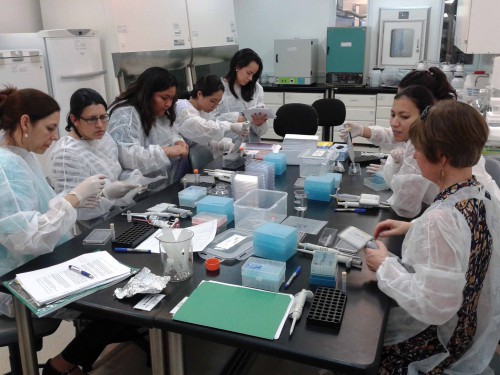Zika virus testing
Fort Collins lab leads Zika testing effort
by Kate Alfano, CMS Communications Coordinator

Public health workers practice the diagnostic tests for Zika virus.
The World Health Organization rang a global alarm over the Zika virus on Feb. 1 when they declared the outbreak a “public health emergency of international concern.” The disease is spreading exponentially in the Americas and the organization predicts as many as four million people could be infected by the end of the year. Since the spring of 2014, more than 30 countries have reported locally acquired cases of Zika. Global health authorities face the delicate task of alerting the world to the dangers of Zika without provoking panic – particularly as affected areas experience increased reports of birth defects and Guillain-Barré syndrome – while at the same time coordinating the four-pronged public health response of diagnosis, treatment, prevention and research.
Health officials at the Centers for Disease Control and Prevention (CDC) have taken the lead in the United States in issuing guidance to patients and physicians on the prevention and evaluation of Zika, with Colorado’s own CDC Division of Vector-Borne Diseases in Fort Collins leading in testing and research.
Robert Lanciotti, PhD, is chief of the diagnostic and reference laboratory within the Arbovirus Diseases Branch in Fort Collins. His lab has been receiving up to 300 samples per day to test from nearly every U.S. state and many countries. He became one of the world’s leading authorities on Zika in 2007 when he and a team traveled to the tiny island of Yap in Micronesia to study the first recorded epidemic. He was lead author of a paper following the trip that analyzed the epidemic and described three diagnostic tests.
As he puts it, Zika was obscure and uninteresting until a little more than a year ago. It was first discovered in 1947 by a researcher working with sentinel monkeys in Uganda and, over the next 60 years, would only be reported in fewer than 10 people in Africa and Southeast Asia. There are roughly 500 vector-borne diseases – viruses transmitted by fleas, ticks and mosquitos – and around 100 can cause human illness. Zika was known to cause human illness but the symptoms were minor: fever, rash, joint pain and conjunctivitis.

Robert Lanciotti, PhD, of the Arbovirus Diseases Branch in Fort Collins, guides learners through his research on Zika.
Concern for Zika heightened when it crossed hemispheres – an alarming sign in the virus world – and heightened further with the suspected connection to microcephaly. Brazilian health authorities contacted the CDC and Lanciotti was part of a team invited to travel to the country in January to conduct a weeklong training of public health personnel from Central and South America.
“There is a critical need to diagnose in Brazil,” he said. “That’s the first thing you need to figure out with an epidemic like this: who’s infected. Then you focus on treatment, prevention and then research. They’re hard workers and they’re getting the job done in Brazil, but slowly. They’re behind and there’s still work to be done. It’s not slowing down.”
That’s what struck him about the trip, the sense of panic. “Eighty percent of the people in Yap were infected with Zika and 75 percent didn’t know they were infected,” Lanciotti said. “They think the number in Brazil may be about the same. There are still some questions about whether Zika virus is causing microcephaly but if it is, it will end up being one of the most devastating viruses in history.”
From an epidemiological standpoint, he sees a strong link between the virus and microcephaly. Two public health workers who attended the training came from Pernambuco, the state of Brazil located in the northeast region of the country where the majority of microcephaly cases have been diagnosed, and the scientists brought photos of the babies, brain scans and laboratory data. Of the babies diagnosed with microcephaly who didn’t survive, they saw clear evidence of virus in their brains, and in the cases where the babies survived, the placenta was loaded with virus, he said.
“What we’ll learn in the next few months is critical to establishing the link between Zika and microcephaly,” Lanciotti said. “The first case in Brazil was detected spring of 2014; nine months later that’s where microcephaly is occurring. Of those countries in South and Central Americas who diagnosed cases of Zika since that time, will we see microcephaly in nine months? That will be one of the proofs of the link between the virus and the birth defects.”
While the work isn’t slowing in Brazil and it isn’t slowing yet in Lanciotti’s lab, it is expected to slow in the U.S. in six to seven months as more state public health labs are trained in running patient samples and as more U.S. patients heed the CDC’s travel advisories to the affected countries. In another month or two, once the initial crisis has passed, the CDC will be able to address the next level – research – working with the National Institutes of Health and other publicly and privately funded companies to answer critical questions and start the long road to developing vaccines.
Posted in: Colorado Medicine | Initiatives

Comments
Please sign in to view or post comments.